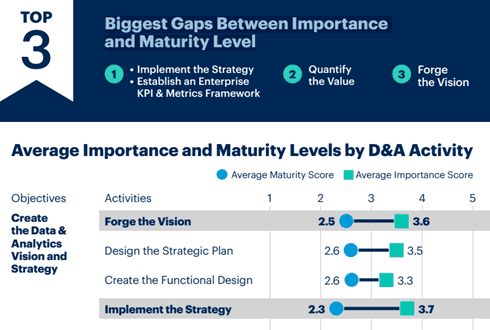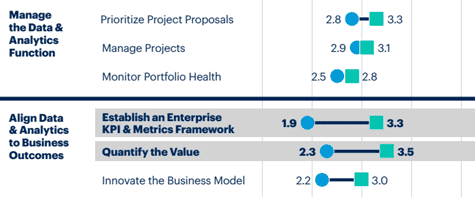- May 18, 2023
- Posted by: Abishek Balakumar
- Category: Data & Analytics

Navigating the VUCA world can be challenging, especially for the BFSI sector. With,
- Volatile market conditions,
- Uncertainty around interest rates and inflation,
- Complex regulatory requirements, and
- Ambiguous economic indicators,
Together it’s a VUCA world, and the industry faces numerous hurdles.
Not Without Pitfalls
With vast amounts of data to process and analyze, the quality and reliability of financial data can be compromised, leading to errors, inconsistencies, and fraud. To keep up, financial services organizations must embrace data analytics, AI, and other emerging technologies to optimize operations, reduce costs, manage risks, and deliver value to their customers. Those who fail to do so risk falling behind in the VUCA world of today.
According to Gartner’s “IT Score Benchmarks for Data & Analytics in Banking, Finance, and Insurance,” BFSI organizations are investing heavily in data and analytics capabilities to improve their decision-making, customer engagement, and risk management.
- Maturity levels in data and analytics indicate how advanced an organization is in implementing and utilizing data-driven strategies and technologies, from early stages to advanced adoption.
- Importance levels reflect the significance of data and analytics activities in driving business value, decision-making, and achieving strategic goals.
However, the report highlights the top 3 biggest gaps between importance and maturity levels, which will be shared exclusively with you. By understanding these levels, organizations can prioritize efforts to improve data quality, implement advanced analytics techniques, and leverage data for informed decision-making, ultimately enhancing their overall data and analytics capabilities.
Challenges to Adopting Data Analytics Transformation in the Banking Industry
Above all, a well-crafted strategy is essential. Without a clear plan of action, investing in data analytics tools and technologies is a waste of time and resources. Here are the “Top 3 Insights from Gartner’s 2023 IT Score Benchmarks for BFSI”


Source: Gartner
Every data analytics effort should be built on a well-defined plan. Without one, you may buy all the technology globally and still spin your wheels. Any effective strategy begins with determining the main goals and objectives you want to accomplish. Not only will this offer you a clear way forward, but it will also make it simpler to interact with key decision-makers. Every company-wide project needs executive buy-in, so adequately explaining what your organization stands to gain through implementing banking analytics may assist in securing a “yes” from those in positions of authority.


Defining which metrics and key performance indicators to measure is difficult if important goals and objectives are not identified. Without a clear vision of what you’re striving for or how to measure success, it becomes more difficult for employees at all levels of your business to support banking analytics projects, which can interfere with organizational change management (OCM) and user adoption efforts. It also prevents you from implementing advanced data analysis in banking as effectively as you might or should: You may ask incorrect questions, preventing algorithms from providing useful insights.
Once you’ve established a solid plan, the next steps are to develop excellent data governance and execute the appropriate technology. Data governance assures that all large data gathered in banking is ethical, compliant, and responsible. It establishes essential requirements for where data is stored, how it is accessed, and how it is utilized — all of which guarantee that your employees are supported and that your data procedures are long-term. This is a target that most businesses in the BFSI sector have not met. But where do we stand on a scale of 1 to 5?


One important aspect missing from our list is setting a clear aspiration. However, we believe every institution should aim to establish analytics as a core business discipline used by decision-makers throughout the organization.
Analytics should be like a reflex, much like the human nervous system, with every part of the bank knowing how to react to specific stimuli. At the same time, different banks may have varying paces in building and training their analytics systems, some nerve paths will already be established, while others need to be developed and taught to react accordingly.
Then, old legacy systems that keep data segregated across multiple lines of business — even from one team member to the next — must be replaced. These divisions need greater work from both consumers and customer-facing team members, slowing operations and severely impacting the customer experience. As a result, banks and other financial institutions must invest in advanced analytics solutions that enable them to address difficulties and provide financial advice in a timely manner.
Overcoming legacy systems and integrating new technologies is no easy task. Let us help you transform your data strategy today.
Learn More
7 Tips for Success
Developing a successful banking analytics strategy requires careful planning and execution. Here are some tips to help set you on the right path:
1. Start Small & Scale Gradually: Instead of trying to take on too much too soon, focus on achieving small wins that can fund future projects while delivering the most significant ROI.
2. Adopt an Iterative Learning Approach: Learn from the experience and adopt an iterative approach to treat each project as an opportunity to improve and learn.
3. Build a Comprehensive Data Ecosystem: Utilize internal & external data sources to build a more comprehensive data ecosystem, providing valuable context and enhancing insights from internal data.

Source: Gartner
4. Right Questions: Determine what information you want to put forward; the right questions that will help you obtain the most meaningful data before committing resources.
5. Choose User-Friendly Solutions: Look for banking analytics solutions that feature intuitive and visually appealing visualizations and dashboards that make data-driven insights easily accessible and understandable.
6. Obtain Executive Buy-In: Executive buy-in is crucial to ensure that employees at all levels of the business are on board with new systems and strategies.
7. Automate Where Possible: Automating low-level service requests saves valuable time and allows employees to focus on high-level requests that drive greater value.
Remember to align your strategy with performance metrics, KPIs, and governance, and assemble a winning team with both data science expertise and industry experience. By following these tips, you can develop a successful banking analytics strategy that drives meaningful insights and improves business outcomes.
Don’t let data privacy and security challenges hold you back. Contact us to learn how we can help you secure your customer data.
Learn More
Energy Shots!
Digital transformation is a never-ending journey for BFSI, as they need to constantly evolve to meet changing customer demands, comply with new regulations, and stay ahead of their competitors. But upgrading legacy systems is not a quick fix and can be complex. Banks must prioritize the most critical areas for modernization and ensure that the transformation is comprehensive, swift, and customer-centric.
To successfully upgrade their core banking systems, banks should:
- Create a clear roadmap that aligns with their vision,
- Identify key metrics for measuring success, and
- Expand their team with domain experts, data specialists, and tech professionals.
They should also prioritize cleaning up their data and ensuring it’s of high quality, conduct training for staff, and document all functional and technical knowledge around the core banking system.
Digital transformation requires careful planning and execution, and banks must be prepared to face new risks and challenges. By following these steps, banks can future-proof their operations, improve customer experiences, and stay competitive in the dynamic financial landscape.




